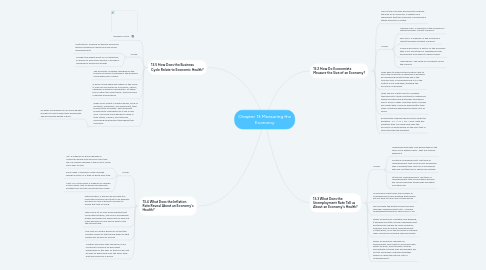
1. 13.4 What Does the Inflation Rate Reveal About an Economy's Health?
1.1. Vocab:
1.1.1. CPI: a measure of price changes in consumer goods and services over time; the CPI shows changes in the cost of living from year to year
1.1.2. Price Index: a measure of the average change in price of a type of good over time
1.1.3. Cost-Of-Living Index: a measure of change in the overall cost of goods and services; another term for the consumer price index
1.2. With inflation, if the prices increase too much the economy will start to go downhill because no one is going to be able to afford the cost of living.
1.3. There are a lot of risks and problems that come with inflation, like loss of purchasing power and banks not being able to give out loans because no one will be able to pay the interest rate.
1.4. The cost of living is going up so that the inflation needs to start going down so that people will be able to survive.
1.5. Inflation will never stay the same, it will continue to bounce up and down depending on the year so that you will not be able to determine over the years how well the economy is doing.
2. 13.5 How Does the Business Cycle Relate to Economic Health?
2.1. Business Cycle
2.2. Vocab:
2.2.1. Contraction: a period of general economic decline marked by falling GDP and rising unemployment
2.2.2. Trough: the lowest point of a contraction, or period of economic decline; a trough is followed by economic growth
2.3. The economy is always changing so the process in which it changes is the business cycle which has 4 steps.
2.4. A boom is the expansion phase of the cycle. It may also be known as a recovery, upturn, upswing, or period of prosperity. All these terms mean the same thing—the economy is healthy and growing.
2.5. When firms invest in capital goods, such as factories, machinery, and equipment, their productivity increases. This increased productivity contributes to a rise in real GDP. Firms hire more people to work in their stores, offices, and factories, increasing employment throughout the economy.
2.5.1. So when companies lay off more people and have to shut down their businesses. The economies health is poor.
3. 13.2 How Do Economists Measure the Size of an Economy?
3.1. GDP is the main way Economists measure the size of an economy. A higher GDP represents that the economy is producing a stable amount of output.
3.2. Vocab:
3.2.1. Nominal GDP: A measure of the economy's output through current currency.
3.2.2. Real GDP: A measure of the economy's output through constant currency.
3.2.3. Informal Economy: A sector of the economy that is not monitored or regulated by the government and doesn't require taxing.
3.2.4. Net Exports: The value of all exports minus the imports
3.3. They have to measure the inflation rate to see if the economy is shrinking or growing. By measuring inflation they see if the nominal GDP is increasing and if it is the output is not changing, showing the economy is growing.
3.4. They use Per Capita GDP to compare themselves to other countries to determine which countries are doing well and which aren't. Even if other countries have a smaller per capita they could be doing better than other countries depending on their cost of living.
3.5. Economists measure the economy with the equation: C + I + G + NX = GDP. With this equation they can show how well the economy is doing based on the GDP that is given through the equation.
4. 13.3 What Does the Unemployment Rate Tell us About an Economy's Health?
4.1. Vocab:
4.1.1. Unemployment Rate: The percentage of the labor force without work , that are actively seeking it.
4.1.2. Frictional Unemployment: The type of unemployment that comes from somebody who is seeking their first job or somebody who has left their job in search for another.
4.1.3. Structural Unemployment: The type of unemployment that comes when workers are laid off because technology has taken over their job.

